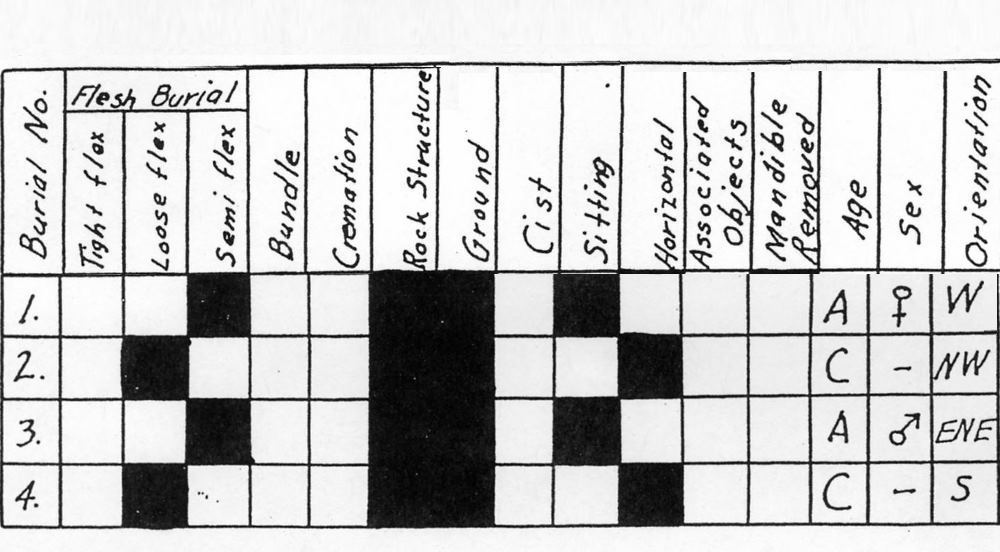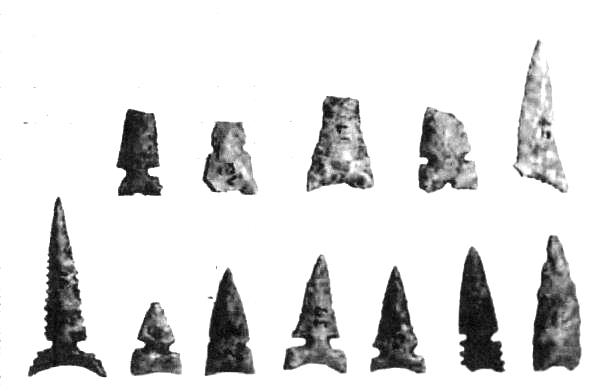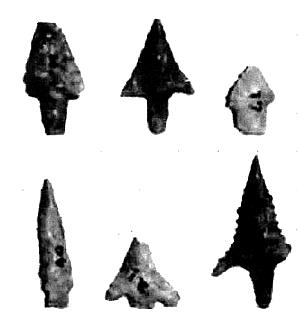Unique among reported cairn sites of the region, the four burials at 41JS50 were recovered from within a burned rock midden at a large campsite. The site was one of numerous prehistoric camps dotting a steep escarpment in one of the typical, sandy, post oak "shinneries," or groves, along the valley of the Clear Fork in Jones County.
Archeologist Joe Ben Wheat investigated the site in 1940, as part of a WPA project in the region, and found the remains of an adult male, an adult female, and two children within a midden deposit with discolored soil more than a foot deep. Although there were dense accumulations of artifacts within the midden, no grave offerings were reported with the burials. In his quarterly report, Wheat described the multiple graves and his version of the prehistoric burial events:
An area peripheral to the main part of the campsite and overlooking the river was chosen and the pit dug through the lower part of the midden and into the sterile sandy stratum below. Later accumulation of midden material had sealed in the grave so that its provenience could be accurately checked. The burial pit was oriented northeast by west-southwest and its diameters were 35 by 26 inches.
Into the pit the body of burial 3 was placed in a sitting position, its back reclining against the northeast wall. The legs were placed forward at right angles to the body with the lower part of the limbs flexed beneath the buttocks.
The body of burial 1 was then placed in such a position that it was seated on the lap of burial three. The legs were then pulled upright in front of its own body and on either side of the body of burial 3. The feet rested at the sides of the pelvis of burial 3.
The flexed burial of a child (burial 4) some six years old was then placed on the bottom of the west end of the pit behind and slightly to the left of burial 1. This burial was oriented to the south with the face to the east. The pit was then filled to a depth of some 14 inches and the flexed body of a second child (burial 2) of the same age as the first was placed behind and to the left of burial 3. Following this interment the pit was filled and rounded river boulders thrown in to form a protective seal or cairn over the grave.
Wheat collected nearly 70 artifacts during excavations at the site. Among these were 26 projectile points and small knives, side and end scrapers, a drill or perforator, and an antler handle with drilled base. Based on artifact photos, there were 18 arrow points among the assemblage, the most prevalent of which are triangular, concave base types, many with side notches. Two of these also have serrated blade edges. Several other points have more straight bases, and basal notches. Today these side-notched points would be classified as type Washita or Harrell. Several other arrow points may relate to the Blow Out Mountain phase types Moran and Chadbourne. The eight dart points cannot be classified based on the image in Wheat's report.
Unfortunately, the report does not provide proveniences which might have established a relative chronology for the midden and, more importantly, for the burial event (s). Based on the artifacts, the site was occupied periodically during Late Archaic (if not earlier) and Late Prehistoric I and Late Prehistoric II times. The multiple-interment grave probably represents a shorter period of use.
|
Of basic importance in this site is the multiple burial which occurred in a pit originating in the midden deposit.
Joe Ben Wheat, 1940 |

Trait chart of burials compiled by Joe Ben Wheat for a quarterly report to the WPA. Manuscript on file, TARL..  |

Side-notched arrow points from site, specific provenience unknown. They are not thought to be related to the burials.  |

Arrow points including types Moran and Chadbourne from Site 41JS50, specific provenience unknown  |
|